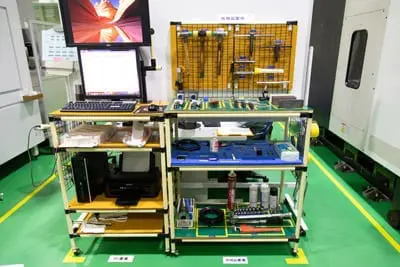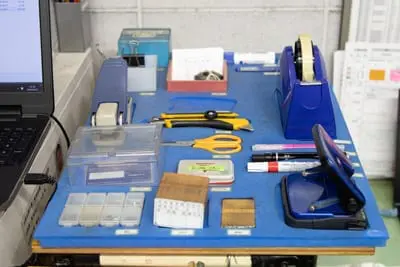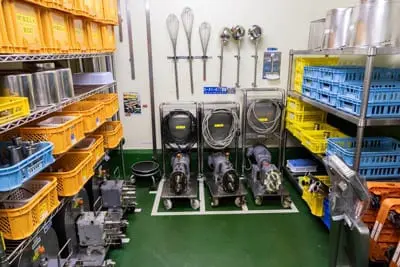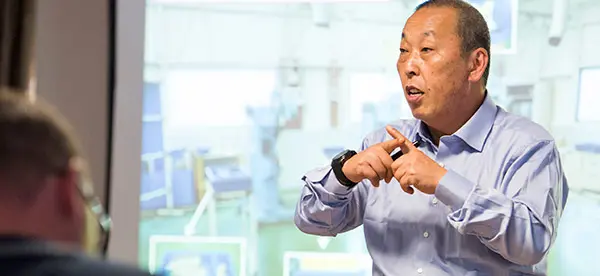The Importance of 5S | The second S – Seiton (Set in Order)
Akinori Hyodo, former Factory Manager, Toyota HiAce Factory | #AskSensei Event 14 Summary
After one goes through the first step of seiri (sort) in 5S, next comes the second step of seiton (set in order). In general, the second S is known as the process of organizing and arranging in order the necessary items kept from the first S process. But, Akinori Hyodo delves deeper into this concept of seiton and discusses that it is all about creating a visual workplace.
Second S of 5S – Seiton (Set in Order)
I will continue on from our previous discussion on the topic of 5S today. Last time I discussed the importance and the idea of the first S of seiri. This time, I will talk about the second S of seiton which is often known as “set-in-order” in English.
Let’s start with the definition of the second S of seiton. What we have done with the first S was separate the necessary and unnecessary items and we are only left with the items that are necessary. With all the necessary items that remain, we want to position each of them in a location that is easy to access, easy to use and easy to see. That is the basic definition of seiton or set-in-order that is quite common around the second S. But, what I would also like to add to this definition is an element of visual management. What I mean by this is that as we proceed with the second S process, we will create a visual workplace where problems can be easily identified.
 Putting it more simply, with the second S implemented properly, in one glance you must be able to see whether things are operating normally or if there is a problem or an abnormality at your workplace. And, if there is a problem and an abnormality, we can quickly identify that and take the appropriate action.
Putting it more simply, with the second S implemented properly, in one glance you must be able to see whether things are operating normally or if there is a problem or an abnormality at your workplace. And, if there is a problem and an abnormality, we can quickly identify that and take the appropriate action.
As I discussed the importance of having standards around the first S last time, this is also important for the second S. So, you must come up with a standardized way of approaching the second S in terms of the method of applying it.
To be more specific, at the second S stage of the 5S process, what we need to do with the remaining necessary items from the first S activities is to come up with the specific locations for those items and determine what should be in each location and in what volume and quantity.
I touched upon this in my previous discussion but to help connect this concept with your personal lives, think about the kitchen at your own home again for a moment. How is your kitchen set up? Take an example of some utensils you keep in your kitchen. For instance, we don’t have an abundance of cutting knives. We only have a small number of cutting knives that we use and many of us have a storage block for those knives which limits the number of knives that can be stored and keeps each in a defined location even though there may not be any labels or indications as to which knife goes where.
Generally speaking, we have specific storage locations for all the utensils and items we have in our kitchen. Since utensils like cutting knives are used very frequently, we have them stored in a location that is close to the point of use. Also, your cutting boards are often kept very close to where you store your cutting knives and they are most likely to be stored in close proximity to the bench space where you do the cutting and food preparation.
If you take this thinking more broadly across the kitchen, in order for you to work in your kitchen in a most optimal and efficient manner, I bet many of the things that you use regularly are located close to the point of use, and the items that are rarely used are stored in a location separate from where we do our main preparation of the meals.
As I spoke about this in my previous discussion, the same thinking also needs to be applied in our workplace when we proceed with the second S process. This should absolutely be the case in a manufacturing environment but we should apply this thinking even in an office environment as well. For example, you can set up your desk area and storage according to the 5S rules.
I trust that the biggest headache many of us have around 5S in our office is probably about what we do with our documents. You may feel like you need all of those documents around your desk and in your office. But, if you went through the process of separating those documents into categories and also into frequency of use such as documents you use daily, weekly, monthly, quarterly, yearly etc. and only had those documents you use on a daily basis right at the closest point to your hands while sitting down at the desk and the next frequency category items a little bit further away and so on, I am sure this will make your workplace easier to work within. What I have touched upon here is to do with physical documents you may have in your office but you can apply this thinking to the digital documents you have in your computer as well.
When we create a document, most of us would see it as necessary document to have. But, when we consider the frequency of our access to the documents we create, I bet there aren’t that many documents we have on our computers that we access very frequently.


Regarding the files on your computer, you should also ask yourself how regularly you would go through your files and delete those files you are no longer using, then reorganize those files and data you are not utilizing so often. If you don’t go through this process regularly, that is when you end up with spending a lot of time searching through unnecessary documents on your computer in order to locate the one we really need. So, I would encourage you to go through the process of the first and second S in your computer as well.
An important point here is that the second S of seiton or “set-in-order” is very hard to accomplish without having done the first S properly to start with. That’s why you need to regularly go through the process of the first S of seiri or “sort” and then ensure that you are applying the second S of seiton or “set-in-order” properly. By going through those two processes again and again, you will be able to see the result of a very clear and visual workplace whether it is in your office or manufacturing shop floor.
Audience Q&A
5S seems to be so simple and “common sense” but it is actually so difficult to implement. What do you think are the reasons for this?
To put it simply and frankly, the answer to this question is that people are not in a difficult position in the first place. People must have been working away at doing their jobs and somehow carrying out what they have to do without having been put into the position where they have to deal with 5S seriously. On top of that, 5S is not something that you can achieve within a day or two. It takes time. It also strongly depends on the amount of awareness as well as the actions and behaviors that those within management have around 5S.
Another point is that the management isn’t either looking at the workplace closely, or they are looking at the workplace and seeing problems but not accepting them as problems.
I have spoken about this before but when you have management looking at their workplace but overlooking issues, they are essentially accepting those issues as being normal. When this occurs, mentally they start not to accept the fact that there are issues, and then not taking action to address those issues becomes normal and a standard state of affairs over time.
As a manager in a workplace, if you actually step through some of the work that is performed on the shop floor yourself, you will start to realize the issues and difficulties that exist in that workplace. And when you find a problem, you address the problem to improve the situation and then standardize the improved way of doing things. When you find the next problem, do the same and repeat the process over and over. In doing so, you will gradually see an overall improvement in your workplace.
It’s the same with anything you try to do in your lean journey but what’s really crucial here is that those at the top of the organization are engaged with this approach and lead those below them by example. Those lower down in an organization are always watching those higher in the organization to learn from them and see what the correct behavior within the organization is. Also, what the top management shouldn’t forget is that it takes time to get those around you and lower in the organization to get fully on board with even one single aspect of 5S because what they are dealing with is changing the behavior of humans. Therefore, you need to be patient. If you start thinking about many different aspects of 5S and trying to change the behaviors of those around you to be on top of 5S, this could take several years or even over a decade. Don’t forget that it is going to be a long process. However, the great benefit of going through that process patiently and tenaciously is that you will create a workplace very comfortable and efficient to work within.
How can we apply the second S (set-in-order) in 5S if we have space constraints on our production floor?
As I mentioned earlier, what’s really important before attempting the second S of set in order is the first S of sort. But, after having done the sort process thoroughly and if you are still limited in terms of space, you can apply the strategy of identifying and separating the remaining necessary items based on the frequency of use. Only have those items you use frequently in close proximity to their point of use. The less frequently used items can be located slightly further away and items that you only use once a year for example can be placed even further away from where all the action is happening.
When I hear people say they don’t have enough space, what I often find when I actually go and see the actual work area is that the comment is being made only considering the floor space. But, there is also an opportunity to use the space above the floor. In an office, you would probably have at least two meters you can utilize in terms of height. On a manufacturing shop floor, you can usually have four or five meters in height that you could work with. But, people often don’t look at that high up. The important point here is to consider the overall space and not just floor space in the building.
Another secret is that when you start to look at the details of those things, even a few centimeters become important. When you add up all those one or two-centimeters spaces and gaps together across an area, it can quickly add up to a meter or so.
However, what we hear and see way too often is that when those on the shop floor say to the management that they don’t have enough space on their shop floor, the management quickly accept that as the truth and start to look at an easy solution rather than challenging those below them to come up with better ways of using the existing space. That’s why what happens often is that the management higher up start to look at leasing another storage facility or building another warehouse etc. and as a result further cost is incurred to the business in various forms.
When we do 5S audits regularly, if we find unwanted items we remove them as we go. Do we still regularly have to do sorting in addition to the 5S audit?


An important part of carrying out these two activities is that since those on the shop floor are putting their efforts into 5S activities with the objective of improving their workplace, they must be able to see the results of the work they have been doing visually and those results must be recognized in the audit.
If you put some effort into doing something, I am sure you want to see if the result of the work you are performing is good or bad. The same thing can be said about the work people do around 5S. Those employees who are making the effort around the 5S would want to see whether the results of what they have been doing are good or bad. And, repeating this process over and over again will change the awareness and behavior of your employees over time.
That’s why it is important to make sure people are made aware of the improvements they are making when their 5S activities are followed up. As part of improving employee awareness around 5S, for example in Japan, we would present a certificate or some kind of recognition to the teams that achieved good results. So, it is extremely important that you have a good system in place to continuously raise people’s awareness around 5S.
How can we start implementing 5S in the chemical industry?
To be honest with you, it doesn’t matter whether you are working in the chemical industry or other types of industry or whether you are in an office or on a manufacturing shop floor. The general thinking behind 5S is exactly the same across everything.
If you reflect on why we are doing 5S, you should realize that the main objective is for us to be able to visualize the problems so that we can take action against those problems. That’s what I would say 5S is ultimately about.
As I have touched upon previously, in order for us to be able to identify the problems we have in our workplace, we need to have standards in place so that we can visually see whether we have a problem or whether things are normal. The reason why you are doing 5S shouldn’t be because other companies around you are doing 5S. And, this overall objective is the same across any industry.
However, what is more specific to the chemical industry is that, unlike disposing stacks of paper for example, it won’t be so easy to dispose of chemicals that are no longer required. Therefore, you need to come up with some standards and processes to deal with this specific point. But, the fundamental thinking and principles that fit into the overall 5S concept are the same and they can be applied in any industry.
Continue Reading | Other 5S Topics in this Series
5S – Seiri – The First S – Sort
5S – Seiton – The Second S – Set-in-order
5S – Seiketsu – The Third S – Sparkle
5S – Seiso – The Fourth S – Shine
5S – Shitsuke – The Fifth S – Sustain
#AskSensei Webinar
#AskSensei is a regularly-scheduled webinar held together with Shinka Management Senior Lean Consultant Akinori Hyodo, who formerly enjoyed a career with Toyota rising from operator and team leader at Toyota, right up to factory manager and director of Toyota’s HiAce Factory. Each event we cover a different topic related to lean, with participants invited to put their questions to Hyodo Sensei.
To be notified of up-coming #AskSensei webinars and other events, sign up to our eNews mailing list at the bottom of this page.


Up-coming #AskSensei Events and Registration
For further information about the #AskSensei webinar series, please refer to our #AskSensei overview page.


